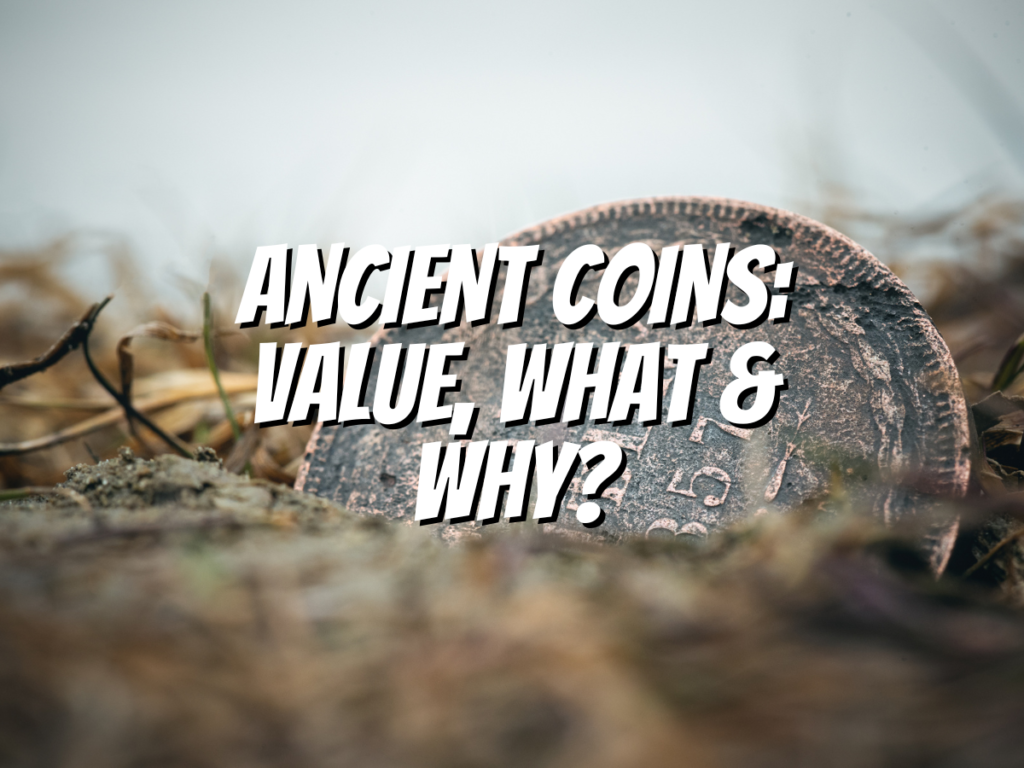Ancient coins typically have precious metals such as gold, silver, or bronze. They are usually found in the soil or around archaeological sites.
Its popularity on the market can vary based on its condition, rarity, historical significance, and more!
In this article, we’ll go deeper and discuss ancient coins and some famous examples!
What are Ancient Coins?

The word “ancient” can refer to a variety of things. The term is used to describe objects from the past and can be applied broadly to anything that’s not new or modern.
In the case of coins, an ancient coin refers to a coin produced in the ancient world (before approximately 600 AD).
Ancient coins are often found by hobbyists who search for them on their property or buy them from coin dealers around the country.
Ancient coins can be made from precious metals like gold or silver or base metals like copper.
What are Considered Ancient Coins?
Coins minted before the 1700s are considered “ancient coins.” The term can be a little confusing because it’s not like they’re ancient people.
They’re just coins! But unlike modern coins, they were made at a time when technology wasn’t nearly as advanced, and they involved much more manual labor and less automation.
Ancient coins date back to the Roman Empire (27 BC – 476 AD), Greek Empire (336-146 BC), and Byzantine Empire (330-1453).
These coins are unique because they were produced during an era in which currency was not yet standardized across Europe or Asia.
Why do People Collect Ancient Coins?
There are many reasons that people collect ancient coins. One of the most important reasons is that it provides a tangible connection to the past.
Ancient coins remind us that thousands of years ago, people were just like us and used money daily. Another reason why people collect ancient coins is that they provide an insight into history.
For example, if you have an ancient coin from Julius Caesar’s time, it can help you understand what life was like back then and how things changed over time as technology evolved or empires rose and fell.
Ancient coins can also be an excellent investment because they have less risk than other investments (such as stocks). Collecting and studying ancient coins can also be fun!
Examples of Popular Ancient Coins
Below is a list of examples of ancient coins you might see while researching.
1. Roman Denarii

These are the most common and popular ancient coins, often considered the first silver coin minted in Rome.
They were typically made from a low-grade silver alloy that was often more copper than actual silver (a higher ratio meant it was easier to strike with less pressure).
They were first struck around 211 BC during the Second Punic War and continued being produced until 235 AD when Constantine I’s new gold solidus replaced them.
They’re well-known since they’ve been around for so long!
2. Greek Tetradrachms

Another prevalent type of ancient coin used throughout Ancient Greece was from around 600 BC until 280 BC, when Alexander The Great conquered them again (and introduced his currency).
Tetradrachms look pretty similar across all different cities but will often have unique letters or symbols on them too!
3. Lydian Stater

Lydian staters are believed to be the ones of the first coins ever made in history!
This coin was introduced before the fall of the Lydian Kingdom in the hands of the Persian Empire.
The earliest record of the coin was believed to date around the second half of the 7th century during the reign of King Alyattes.
4. Persian Daric

In 550-530 BC, Cyrus the Great introduced coins to the Persian Empire following his reign over Lydia.
Cyrus adopted the coinage system introduced by the Lydian empire and continued to strike Lydia’s Lion and Bull coinage.
5. Chinese Cash

Chinese cash was a currency used in China during Imperial times. It was the chief denomination until the yuan was introduced in the late 19th century.
China has one of the most unique coins ever made in history! From their knife money, ant-nose coins, Ying Yuan, Sycee, and even Spade money. Their coins come in different shapes and sizes!
Are all Ancient Coins Valuable?
Ancient coins are valuable because they are old, rare, and in good condition.
The older the coin, the more valuable it is. A coin can be worth $100 if it’s only 75 years old, but a tiny percentage of people would pay that amount for it.
It could be worth $10,000 if it’s 3,000 years old, though! So always ask yourself: “How old is my ancient coin?”
The next important thing to consider when determining how much your ancient coin will sell is its rarity.
Rarity means how many copies there are of any given type of ancient coin still around today compared to other types of coins from different eras or countries (e.g., Roman coins vs. U.S Dollar coins).
For example, if you think about all the gold bullion bars around the world today, there are likely only a handful that was made during any period in history (e.g., the 1800s).
Before you go…
Ancient coins are a great investment, and they have been throughout history. There are many different types of ancient coins, and each one can be pretty valuable.
Check out my next article: “100 Ancient Coin Names.”
Related Articles:

